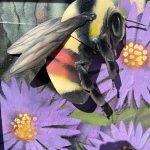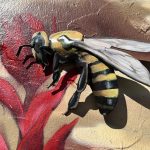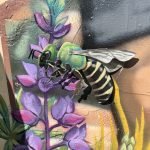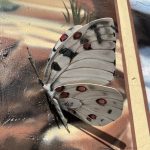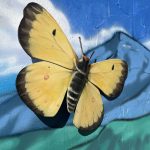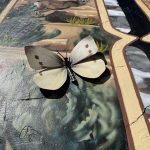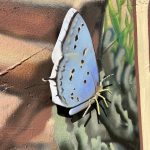Bees and Butterflies of Gunnison, Colorado
This guide to the bees and butterflies of Gunnison, Colorado features some of this area’s most common insects, including vital pollinators. If you enjoyed learning about the insects of this area, also check out the guides to plants and wildlife.
Mural at IOOF park

This guide was designed to accompany the mural at IOOF Park, located at 124 E. Virginia Ave. in downtown Gunnison. Each species of insect featured on the mural is listed here, along with a photo of its likeness on the mural. Can you find them all?
About the authors
Patrick Magee, Ph.D., is the Associate Professor of Wildlife & Conservation Biology at Western Colorado University in Gunnison. In addition to teaching courses at Western, Dr. Magee is a wildlife biologist specializing in wildlife conservation efforts across the American West.
Western Colorado University ecology graduate students Mia MacNeill, Caitlin Harvey, Tim Andrews and Caleb Park contributed to this project.
Click or tap on the photo to learn more about that species.
Orange-belted Bumblebee or Tricolored Bumblebee
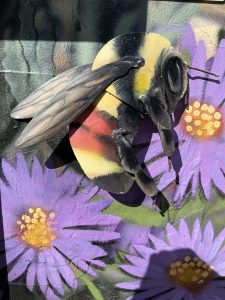
Latin name: Bombus ternarius
Insect Family: Apidae or Bee Family
The orange-belted bumblebee is native to the U.S. and Canada. They are not located in Colorado, but they are similar to other local butterflies with orange belts. Orange-belted bumblebees tend to use wet coniferous forests with moderate to high plant density compared to more open sites. In late April, the queen comes out of hibernation to find a nest site, forage for pollen and nectar, and lay fertilized eggs to become workers. Offspring stages include egg, larva, pupa and adult. The new workers take over foraging expanding the nest and taking care of eggs and larva. In late summer the queen lays unfertilized eggs to become male drones for reproduction. Near the end of the queen’s life, she lays fertilized eggs to give rise to new queens. The rest of the colony dies mid-autumn. Pheromones from the queen, larvae diet and the larvae themselves may have a role in determining if a fertilized egg will become a worker or queen. An orange-belted bumblebee can sting repeatedly without dying because its stinger does not have harpoon-like barbs (like a honey bee). However, this bumblebee will only sting when defending the nest or if threatened. Flight requires great amounts of energy. The tricolored bumblebee eats and collects nectar and pollen of many flowers, including willow, white clover, oxeye daisy, white meadowsweet and cinquefoil flowers. Tricolored bumblebee populations have slightly increased from historic numbers and shifted to higher elevations. Many bumblebee declines in Colorado are linked to intensified large-scale agriculture. Wildlife-friendly approaches to agriculture, including hedgerows, integrated pest management to target certain species, or setting aside land, are the best ways to conserve bumblebee species.
(Sources: Brooks and Nocera. 2020. Canadian Journal of Forest Research 50:1399–1404., Butler et al. 2021. Environmental Entomology 50:1358–1369., Grixti et al. 2018. Biological conservation 142:75–84., Jacobson et al. 2018. Biological Conservation 217:437–445., McFarland et al. 2015. http://val.vtecostudies.org. 09/19/2022., Encyclopedia of Life. Encyclopedia of Life (eol.org))
Western or European Honey Bee
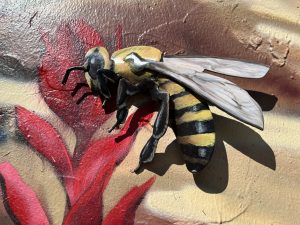
Latin name: Apis mellifera
Insect Family: Apidae or Bee Family
The most prolific of the honey bees is the western honey bee, also known as the European honey bee. It can be found on every continent except Antarctica. The species was spread largely by humans to boost pollination and fruit production, and has since naturalized across the world. In addition to their role as pollinators, western honey bees are also a major producer of honey and beeswax, which are often harvested for human consumption. Part of their widespread success is the result of their complex communication system and social hierarchy. These bees can communicate with other individuals about the distance and direction to a food source through a series of intricate body movements, often referred to as dances. They also use chemical signals, called pheromones, to warn about threats, communicate about mating, and determine if an individual is from the same hive. Within each hive, every individual has one of three roles in a well-defined social structure. A female can either be a queen bee or a worker. Each hive has only one queen, and she is the only one capable of reproducing. Her main role is to produce new offspring. The other females are known as workers and serve many important functions within the colony, including raising the young, and foraging for nectar and pollen. The males, called drones, do not contribute to parental care or food production, but rather focus their attention on fertilizing the queen so she can lay more eggs. These well-defined roles, along with their intricate communication system, has allowed the bees the adapt well to a variety of different environments. Even so, honey bees today are facing unprecedented threats, particularly from nonnative parasites and colony collapse disorder, which is leading to a suspected decline in healthy populations. In addition, non-native honey bees in North America represent a significant threat to wild bees.
(Sources: Aslan et al. 2016. Natural Areas Journal 36:478-488., Beekman and Ratnieks. 2000. Functional Ecology 14:490-496., Blum. 1992. Honey bee pheromones in The Hive and the Honey Bee., Calderone. 2012. PloS One 7(5)e37235., Crane. 1991. Ethology, Ecology and Evolution 3:100–105., https://animaldiversity.org/accounts/Apis_mellifera/, https://www.inaturalist.org/taxa/47219-Apis-mellifera)
Green Sweat Bee

Latin name: Agapostemon virescens
Insect Family: Halictidae or Sweat Bee Family
The green sweat bee is one of the more captivating insects, with their bright, metallic green body. Its range covers much of the U.S. and south to Central America and parts of South America. Green sweat bees nest underground. Nests contain one main vertical tunnel, with tunnels that branch off horizontally to “cells” where females lay a single egg. Up to 30 females share this subterranean nest. Each female packs an individual cell with pollen and nectar, and then lays her egg on top. The cell is then covered up, and when the young bees mature, they dig their way out to the main part of the nest. Female sweat bees that emerge from the cell start taking on the daily chores of a female bee in the colony, such as nest guarding and collecting pollen. Males disperse from the nest, and their only task is reproduction. Green sweat bees are attracted to people during the summer. They seek perspiration from hot, sweaty bodies! While this may cause alarm, they are not aggressive and rarely sting unless hit or squished.
(Sources: Roberts. 1973. Bees of Northwestern America. Agricultural Experiment Station, Technical Bulletin 125. Oregon State University Corvallis, Oregon., Abrams and Eickwort. 1980. Agriculture 1980:1-20., Abrams and Eickwort. 1981. Insect Soc. 28:105–116.)
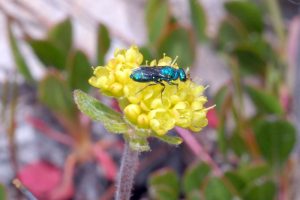
Green sweat bee. Photo by David Inouye.
Rocky Mountain Parnassian or Apollo Butterfly
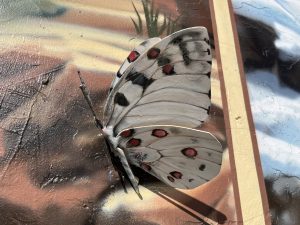
Latin name: Parnassius smintheus
Insect Family: Papilionidae (Sub-family: Parnassiinae)
The high-altitude Rocky Mountain parnassian’s name is steeped in rich mythological origins. The group of butterflies from the subfamily Parnassiinae is named for the inspirational Mount Parnassus in Greece, a sacred place where Apollo, the God of sun and light, drew vision and creativity from the muses. The beautiful and intricately patterned parnassian butterflies also go by the name “Apollo,” again referencing the God most associated with youth and beauty. The Rocky Mountain apollo has distinctively white-and-black-striped antennae and bold black patterns on its white body with prominent red dots, especially on the hind wings. They are primarily associated with the tiny plant called stonecrop. Females lay one egg at a time on the plant, and the eggs overwinter. Larvae hatch in spring and eat the leaves of stonecrop.
(Sources: USGS Butterflies of North America, Butterfliesandmoths.org)
Western Tiger Swallowtail
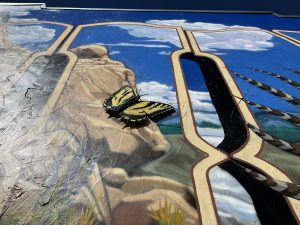
Latin name: Papilio rutulus
Insect Family: Papilionidae or Swallowtail Family
Known for its bold black and yellow pattern, and its split tail that resembles a swallow, the western tiger swallowtail is one of the most commonly recognizable species of butterfly in Colorado. This butterfly species frequents wooded parks, stream banks, and backyards. In the summer, males patrol streams, canyons, and hillsides looking for a mate. They may join flocks of male butterflies of different species. In Colorado, tiger swallowtails lay their eggs on the leaves of cottonwoods, willows and aspen. After hatching from their eggs, the caterpillars feed on the leaves of the host plants, which propels their development toward adults. Because of this association with specific plants, western tiger swallowtails serve as an “indicator” species, meaning that their presence can show a healthy community of plant species in an area. The western tiger swallowtail’s range includes southeastern Colorado and parts of southwestern South Dakota; all the way to the West coast; north, to British Columbia, Canada; and south to southern Arizona.
(Sources: Butterflies and Moths of North America 2019 https://www.butterfliesandmoths.org, Huntzinger. 2003. Biological Conservation 113:1–12., Scriber et al. 1991. The Great Lakes Entomologist 24)
Clouded Sulphur
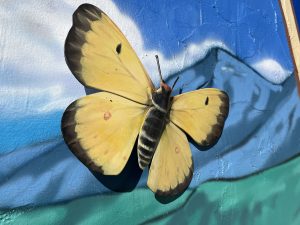
Latin name: Colias philodice
Insect Family: Pieridae or White and Sulphur Family
The range of the non-migratory clouded or common sulphur extends over most of the North American continent, from Alaska and parts of Canada to northern Mexico, with some populations as far south as Guatemala. In Colorado, clouded sulphurs occur throughout the state. They often occupy disturbed and open habitats, such as grasslands and open meadows, at elevations between 4,600-9,500 feet. Clouded sulphurs also inhabit wooded riparian areas, and commonly associate with other butterfly species such as the variegated fritillary and common checkered-skippers. Distinct yellow and black coloring on their spotted wings distinguishes the species from other butterflies, and within the species, males and females differ. The wings of females have a larger black border than that of males, as well as the presence of yellow spots. Common sulphurs have a 1-2 inch wingspan, making them medium-sized butterflies, with females larger than males at full maturity. Clouded sulphurs produce two or three broods per year, with females laying elongated reddish eggs. Once larvae hatch, they feed exclusively on legumes such as clover and alfalfa. As they reach the pupal stage, they encase themselves in a green cocoon that is held up by a silken girdle. After clouded sulphurs emerge as adults, they enter the final stage of their lifecycle, which is reproduction. The lifespan of adult clouded sulphurs is relatively short, typically only 2-7 days. During this phase, clouded sulphurs often congregate around puddles, a behavior known as “mud puddling.” While mud puddles may not seem particularly beneficial, the butterflies collect nutrients from the damp soil.
(Sources: naturecanada.ca/news/blog/whats-a-clouded-sulphur-you-ask/, Butterflies and Moths of North America, Dollar. 2011. https://scholarsjunction.msstate.edu/td/3809, www.massaudubon.org/learn/nature-wildlife/insects-arachnids/butterflies/find-a-butterfly, Higgins et al. 2015. Physiological Entomology 40:189–195., Holway. 1933. Masters Theses https://scholarworks.umass.edu/theses/1618, Lang et al. 2020. Journal of Insect Conservation 24:375–383., Nelson and Nelson. 2001. Urban Ecosystems 95–108.)
Cabbage White
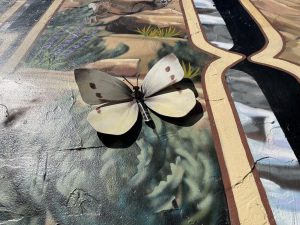
Latin name: Pieris rapae
Insect Family: Pieridae or White and Sulphur Family
Commonly seen flying around Colorado in the late spring and summer, the cabbage white is not actually native to North America. The species was accidentally introduced to Montreal in the 1860s before spreading across the United States and Canada. Since that time, the cabbage white has made itself quite at home feasting on the nectar of the wide array of wildflowers the Gunnison Valley has to offer. But when it comes time to lay its eggs, they prefer the leaves of plants in the mustard family, like tall tumblemustard and watercress. However, as their name suggests, their favorite plant is cabbage and similar crops, which causes many people to consider them a pest because of the damage they can cause to these important food sources. The green caterpillars blend in with their surroundings, but even so they are often preyed upon by birds and large invertebrates. The immature butterfly (larva) matures over two to three weeks before sealing itself into a chamber or chrysalis, where it transforms into the recognizable adult butterfly. This cycle can occur three to five times over the course of one summer for individual caterpillars that transform into adults and then lay eggs. As colder weather approaches, the pupae will remain in their chrysalis throughout the winter before emerging in the spring when the cycle begins again. This overwintering hiatus in development is called a diapause.
(Sources: Parker. 1970. Annals of the Entomological Society of America 63:985–994., Remington. 1952. Psyche, 59:61-70., Richards. 1940. The Journal of Animal Ecology 9:243., Jones et al. 1980. The Journal of Animal Ecology 49., Suzuki. 1978. Applied Entomology and Zoology 13:312-313, Moiseeva. 1984. Zashchita Rastenii 11:44-45., Chittenden. 1916. No. 766, US Department of Agriculture., Capinera. 2008. University of Florida Institute of Food and Agricultural Sciences.)
Uncompahgre Fritillary

Latin name: Clossiana improba acrocnema
Insect Family: Nymphalidae or Brush-footed Butterfly Family
The Uncompahgre fritillary butterfly (UFB) is a federally endangered butterfly species discovered in 1978. Endemic to western Colorado, the UFB has a limited distribution only in alpine habitats in the San Juan Mountain range. The diminutive UFB has a wingspan of only two to three centimeters. Males have brown wings with black lines throughout the wing, whereas females are lighter. UFBs reside within patches of snow willow (Salix nivalis), which grows above 12,000 feet in alpine ecosystems. While adults suck nectar from a variety of alpine species, snow willow is the lone host plant for the specialized, herbivorous UFB larvae. Biennial UFBs complete their life cycle and development over the span of two years. During the first year, larvae overwinter underneath snow before molting in the spring once they re-emerge. Once UFBs transition from the pupal stage to adulthood, they have a relatively short lifespan, flying for only three weeks beginning in early July. Their lifespan depends on annual snowfall and a variety of environmental conditions. UFB adults seem reluctant to fly, and must be wary of summer thunderstorms and winds. Threats to UFB populations include illegal harvesting by butterfly collectors, and habitat degradation from grazing and human activity. Climate change threatens this species due to narrowing the availability of high-elevation habitat used by UFB colonies. Listing of the UFB under the Endangered Species Act (ESA) has protected the species since 1991. Continued monitoring and conservation efforts are of vital importance to the survival of the species. Since the listing under the ESA, known populations have increased from two to eleven.
(Sources: Britten et al. 1994. Conservation Biology 8:1158–1160., Britten. 1994. Conservation Biology 8: 86–94., Gall. 1984. Biological Conservation 28:1–28., Monroe et al. 2016. Journal of Insect Conservation 20:305–313., Scott. 1982. https//mountainscholar.org/handle/10217/84910, Species Profile for Uncompahgre fritillary butterfly (Boloria acrocnema) https://ecos.fws.gov/ecp/species/4419)
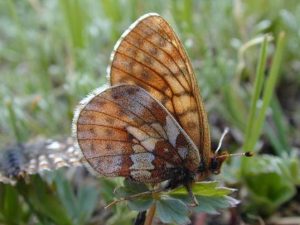
Uncompahgre fritillary butterfly. Photo by Kevin Alexander.
Western Tailed-Blue

Latin name: Cupido amyntula
Insect Family: Lycaenidae or Gossamerwing or Hairsteak Family
The Western tailed-blue lives throughout western North America from southern Alaska to northern Baja California, including the western slope of the Rocky Mountains. Eggs are laid singly on legume host plant flowers or pods including sweet peas and locoweed, American vetch, and wiry milkvetch. Western tailed-blue caterpillars eat into the host seed pod, consume the seeds and seal themselves into the pod for the winter. Larvae eat flowers, fruit and young leaves. Larvae are tended by ants and older larvae. In spring and summer, new butterflies take flight. New butterflies emerge May to September and may consist of one or two generations. Adult butterflies visit white, yellow and purple flowers of wiry milkvetch, sweet pea and spearleaf stonecrop. However, Western tailed-blues also visit urine, dung, manure and mud to replace their salts and amino acids. Males in particular do this to help improve reproductive success of eggs. Adults roost on low vegetation and Gambel oak. Adults prefer habitats with high densities of host and nectar plants, and available forest openings. In gulch bottoms, valley bottoms and swales, males watch for receptive females to mate with. The males are purple-blue, while the females are slate gray with some blue on the wing base. They have a fairly small wingspan at 7/8 to 1 1/8 inches. Western tailed-blues live in open areas and woodlands. In Roxborough State Park in Colorado, researchers found that this butterfly’s timing of life events is changing because of warmer winter, increased habitat quality, or is part of the species natural variation. Interestingly, Western tailed-blues may be increasing their number of broods per year from one to two. Lidar or remote sensing information and behavioral and range studies help land managers support sensitive pollinator species by conserving critical habitat.
(Source: Hess et al. 2011. American Society for Photogrammetry and Remote Sensing Annual Conference 191–196., Hess et al. 2013. Null 4:354–363., Pocewicz et al. 2009. Journal of Insect Conservation 13:593–601., Pyle. 2010. News Lepidopt Soc 52:54–57., Rutowski. 1991. American Naturalist 138: 1121–1139., Nelson. 2020 The Journal of the Lepidopterists’ Society 74:244–256., Scott. 2020. Butterflies of the southern Rocky Mountains area, and their natural history and behavior. Colorado State University Libraries., Scott. 1987. American Midland Naturalist 117: 103., Ullman. bentler.us/eastern-washington/animals/insects/butterflies/western-tailed-blue-butterfly.aspx., Western Tailed-Blue. 2022. http://coloradofrontrangebutterflies.com/western-tailed-blue.)
Where to find these butterflies and bees
It’s nearly impossible to miss seeing insects while hiking, mountain biking, gravel biking or fishing in the backcountry around Gunnison. You might even encounter them on the deck of your favorite restaurant in downtown Gunnison! Butterflies and bees are most common during the late spring, summer and early fall.
